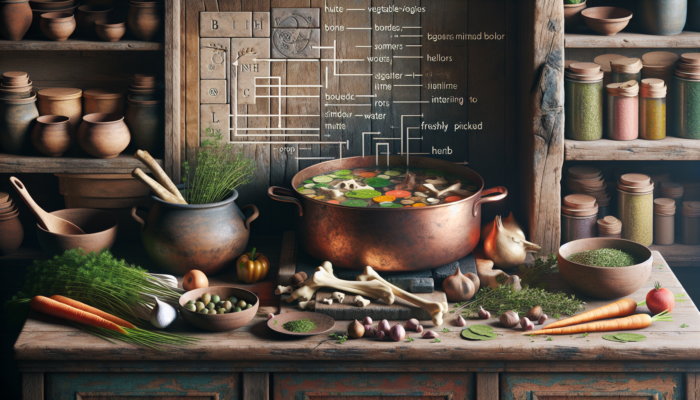Master the Craft of Flavorful Homemade Stock Using Kitchen Scraps for Sustainable Cooking
Acquiring the skill of crafting your own homemade stock is not only a vital culinary technique but also an environmentally conscious choice that enhances the taste of your meals. By learning how to create homemade stock from scraps, you elevate the flavors of your culinary creations while minimizing food waste, which is beneficial for both your kitchen and the planet. In this guide, we will delve into the essential elements that will set you on the journey of successfully making rich and flavorful stock.
Unlock Exceptional Stock Quality with Fresh Kitchen Scraps

The freshness of your ingredients is paramount when it comes to the quality of your stock. Utilizing fresh scraps not only results in a robust and flavorful stock but also serves as a versatile base for an array of dishes, from hearty soups to gourmet sauces. Fresh vegetable scraps such as onion skins, carrot tops, and celery leaves contribute vibrant flavors and essential nutrients that elevate the overall taste of your stock. Additionally, fresh meat scraps, including bones and trimmings, enrich the flavor profile with depth and complexity. Always prioritize using scraps from fresh produce and meats, as spoiled items can negatively impact both the safety and taste of your stock.
Key Ingredients for Crafting Premium Quality Stock
Making stock can be an uncomplicated process that emphasizes simplicity and ingredient quality. The fundamental components you will need consist of water, a mix of vegetables, and meat scraps. Water is the essential base that acts as a medium to draw out flavors from your scraps. When it comes to vegetables, aim to use often-discarded parts like onion skins, carrot peels, and garlic cloves. For those looking to create meat-based stock, bones and trimmings from chicken, beef, or any other meat provide a solid flavor foundation. Incorporating herbs such as parsley, thyme, or bay leaves can drastically enhance the aroma and taste of your stock, turning it into something genuinely delightful.
Optimal Cooking Time and Temperature for Creating Perfect Stock
A vital aspect of successfully making stock is mastering the cooking time and temperature. It is essential to allow the stock to simmer gently for at least two hours on low heat. This slow cooking technique enables the flavors to meld together beautifully while maximizing the extraction of nutrients from the scraps. Be mindful, as excessive heat can lead to a bitter taste and an unappealing cloudiness in your stock. Therefore, keeping a low flame and gentle simmer throughout the cooking process is critical. For meat-based stocks, consider extending the cooking time to at least four hours or longer, especially when using larger bones, to guarantee that every bit of flavor is fully extracted.
Your Comprehensive Guide to Crafting Flavorful Homemade Stock from Kitchen Scraps

Creating stock from scraps is not only an accessible endeavor but also a rewarding experience that anyone can master. Follow this detailed step-by-step guide to ensure that your stock is overflowing with flavors and nutrients.
Smart Strategies for Collecting and Storing Kitchen Scraps Efficiently
Start by accumulating a diverse selection of vegetable and meat scraps over time. Designate a specific container in your refrigerator or freezer for storing these scraps. This container can house onion peels, carrot tops, celery leaves, and any available meat trimmings. The beauty of this method lies in the gradual accumulation of scraps, making stock-making a convenient and eco-friendly practice. Aim to gather enough to fill a large pot when you decide to prepare your stock, ensuring you are well-equipped to begin the cooking process.
Preparing Your Cooking Pot for Efficient Stock Creation
After gathering your scraps, it’s time to prepare your pot. Choose a large pot that can comfortably accommodate all your scraps and water without risking overflow. While a stockpot is ideal, any sizable pot will suffice. Add your vegetable and meat scraps to the pot, ensuring a balanced mixture to optimize flavor extraction. Fill the pot with cold water, covering the scraps by about an inch. Starting with cold water is crucial, as it effectively extracts flavors during the cooking process, leading to a richer final product.
Maximize Flavor Extraction by Simmering Your Stock

Place your pot on the stove and bring it to a gentle boil. Once it reaches a boil, reduce the heat to low to maintain a gentle simmer, which is a crucial stage in stock-making. Allow it to simmer for a minimum of two hours, stirring occasionally to prevent the scraps from adhering to the bottom. For meat stocks, consider simmering for four hours or longer. As your stock simmers, you’ll witness it transform into a beautiful golden hue while a rich and inviting aroma fills your kitchen. This slow simmering technique allows the flavors to meld together harmoniously, resulting in a nutritious and delicious base for all your culinary masterpieces.
Straining Your Stock for Clarity and Enhanced Flavor Profile
Once the simmering process is complete, it’s time to strain your stock. Carefully remove the pot from the heat and allow it to cool slightly. Using a fine mesh strainer or cheesecloth, strain the stock into another pot or bowl, discarding the solids. This essential step is crucial for achieving clarity and a refined flavor in your stock. If you prefer an even clearer stock, consider straining it multiple times. After straining, let the stock cool completely before storing it in the refrigerator or freezer to maintain its freshness and flavor.
Uncover the Benefits of Making Stock from Kitchen Scraps
Crafting stock from scraps is not merely a sustainable practice; it offers numerous advantages that make it a wise choice for any home cook looking to enhance their culinary skills.
Reduce Food Waste While Saving Money
Utilizing scraps significantly decreases food waste while also saving you money. Rather than purchasing pre-made stock or broth, you can create your own using ingredients that would otherwise be discarded. This economical approach is particularly beneficial for those on a budget or anyone aiming to be more mindful of their grocery expenses. By repurposing scraps, you ensure that every part of your food contributes to a delightful meal, fostering a more cost-effective and efficient cooking practice.
Elevate the Nutritional Value of Your Meals with Homemade Stock
Another notable benefit of making stock from scraps is the enhancement of nutritional value it provides. Vegetable scraps often contain vitamins and minerals that boost the health benefits of your stock. For instance, carrot tops are rich in vitamin C and dietary fiber, while onion skins are loaded with antioxidants. Additionally, meat scraps, especially bones, are abundant in collagen, which supports joint health. Therefore, the stock you create not only enriches flavor but also adds a nutritious element to your meals.
Make a Positive Environmental Impact Through Sustainable Cooking Practices
By utilizing scraps for homemade stock, you take a significant step towards reducing landfill waste, making it an environmentally friendly choice. Maximizing your food use contributes to a more sustainable kitchen while lowering your overall carbon footprint. This practice encourages a resourceful and sustainable mindset that can extend beyond your cooking habits. Sharing your stock-making experiences with others can inspire a community-wide movement towards reducing food waste and promoting sustainable culinary practices that benefit everyone.
Choosing the Best Kitchen Scraps for Flavorful Stock Creation
Selecting the right scraps is vital for crafting a delicious and aromatic stock. Here’s a detailed overview of the best types of scraps to utilize for optimal flavor extraction.
Enhance Flavor with Quality Vegetable Scraps
Vegetable scraps serve as the foundation for a flavorful stock. Ingredients such as onion skins, carrot tops, garlic cloves, and celery leaves are among the most effective choices. These components add depth and sweetness to your stock, creating a strong base for soups and sauces. Additionally, you can include herbs like parsley stems, thyme, and bay leaves to infuse your stock with wonderful aromatic qualities. Experimenting with various combinations allows you to discover your preferred flavor profile, ensuring that your stock is both distinctive and delicious.
Achieving Richness with High-Quality Meat Scraps
For those who aspire to create a rich meat stock, incorporating bones and meat trimmings is essential. Chicken carcasses, beef bones, and pork scraps work beautifully, providing depth of flavor that vegetable scraps alone cannot offer. Roasting the bones before adding them to your stock can intensify their flavor, imparting a caramelized note to your final product. The collagen released from the bones during the simmering process adds body and richness to your stock, making it an indispensable ingredient for hearty soups and stews.
Elevate Flavor with Herb Scraps
Herb scraps, often overlooked, can elevate your stock to new culinary heights. Stems from fresh herbs like parsley, cilantro, and thyme impart a fragrant aroma that enhances the overall taste. You can also experiment with stronger herbs like rosemary or sage to add a distinct character to your stock. Remember, balancing flavors is crucial; use herb scraps sparingly to avoid overpowering the other ingredients.
Strategic Storage and Freezing Techniques for Your Homemade Stock
Once you have successfully crafted your stock, proper storage is crucial for maintaining its freshness and flavor. Here are some effective strategies for storing and freezing your homemade stock.
Quick Cooling Techniques for Stock Safety
Before storing your stock, it’s vital to cool it rapidly to prevent bacterial growth. Divide the hot stock into smaller portions in shallow containers to facilitate quicker cooling. Alternatively, consider placing the containers in an ice bath to expedite the cooling process. Once the stock reaches room temperature, transfer it to the refrigerator if you plan to use it within a few days, or proceed to freeze it for longer-term storage.
Freezing Stock in Convenient Portions for Easy Access
Freezing your stock in manageable portions ensures that you have it readily available when needed. Ice cube trays are perfect for this purpose; simply pour the cooled stock into the trays, freeze, and then transfer the cubes to a freezer bag. This approach allows you to defrost only the amount required for your recipes, significantly reducing waste while ensuring your stock retains its quality over time.
Labeling and Dating Frozen Stock for Optimal Freshness
Always label and date your frozen stock to keep track of its freshness. This simple yet effective practice can save you from the disappointment of discovering that your stock has been in the freezer for too long. Typically, homemade stock can be stored in the freezer for up to six months. After this duration, its flavor may diminish, so keep an eye on your supply and utilize it within this timeframe for the best results.
Avoiding Common Pitfalls When Making Stock
While making stock is relatively straightforward, there are common mistakes that can lead to unsatisfactory results. By steering clear of these errors, you can ensure that your stock is both delicious and nutritious.
The Dangers of Overcooking Your Stock
One of the most frequent mistakes people encounter is overcooking the stock. Although it may seem logical that a longer cooking time yields a more flavorful stock, overcooking can lead to bitterness. Aim for a gentle simmer, closely monitoring your cooking duration. For vegetable stock, 2 to 3 hours is sufficient, while meat stocks may require 4 hours or more. Trust the process and resist the urge to rush for the best flavor outcome.
Ensuring Freshness: Never Use Spoiled Scraps
Another essential mistake is incorporating spoiled scraps, which can ruin the flavor of your stock and pose health risks. Always inspect your vegetable and meat scraps before adding them to the pot. If any scraps show signs of spoilage, it’s best to discard them rather than compromise the quality of your stock. Freshness is vital, so be diligent in selecting your ingredients to guarantee a safe and tasty result.
The Importance of Skimming Impurities for Clear Stock
Neglecting to skim off impurities during the cooking process can lead to a cloudy stock. As the stock simmers, various impurities will rise to the surface. Use a ladle or skimmer to remove these impurities, resulting in a clearer, more refined stock. This crucial step not only enhances the appearance but also improves the taste, making your stock more visually appealing and enjoyable.
Creative Culinary Applications for Your Homemade Stock
After mastering the art of making stock from scraps, the next step is to explore its use in inventive recipes. Here are some inspiring ideas to elevate your culinary creations.
Crafting Hearty Soups and Stews Using Homemade Stock
Homemade stock serves as an outstanding foundation for robust soups and stews. Whether you’re preparing a classic chicken soup or a hearty beef stew, using your stock adds a depth of flavor that store-bought options simply cannot replicate. Experiment with diverse ingredients and spices to create dishes that reflect your unique tastes and culinary style.
Enhancing Sauces and Gravies with Rich Homemade Stock
Elevate your sauces and gravies by incorporating the rich flavor of homemade stock. Whether you’re crafting a simple pan sauce or a complex gravy for a roast, substituting stock for water or store-bought broth will elevate your dish to new culinary heights. The depth of flavor in your stock will shine through, making your sauces more robust and delicious, providing an exceptional dining experience for your guests.
Infusing Flavor into Risotto and Rice Dishes with Stock
Using stock as the cooking liquid for risotto or rice dishes imparts incredible depth of flavor. Instead of plain water, substitute it with your homemade stock for a richer and more satisfying meal. The stock will infuse the grains with its essence, ensuring that each bite is a delight. This technique works beautifully for any rice dish, from pilafs to paellas, enhancing the overall dining experience.
Braising Meats for Optimal Tenderness with Homemade Stock
Homemade stock is ideal for braising meats, providing both flavor and moisture for a tender outcome. Whether you’re braising beef, pork, or chicken, using your stock as the braising liquid ensures that the meat absorbs all the delicious flavors. The result is a succulent dish that showcases the effort you invested in making your stock, impressing everyone at your table.
The Environmental Impact of Using Kitchen Scraps for Stock
Making stock from scraps is not only a practical cooking technique but also offers substantial environmental benefits. Here’s how your culinary efforts can positively influence the planet.
Significantly Reducing Food Waste
By making stock from scraps, you actively contribute to the reduction of food waste. Each year, a staggering amount of food is discarded, resulting in overflowing landfills and increased greenhouse gas emissions. By repurposing scraps that would otherwise go to waste, you are making a conscious decision to lessen your environmental footprint while maximizing your resources.
Lowering Your Overall Carbon Footprint
Every bit of food waste that ends up in a landfill contributes to your carbon footprint. By using scraps for homemade stock, you help minimize your carbon emissions. The more we can do to reduce waste, the smaller our overall environmental impact becomes. This small change in your cooking habits can lead to significant improvements in sustainability, making a meaningful difference.
Inspiring Sustainable Cooking Practices in Your Community
Sharing your knowledge of making stock from scraps can motivate others to adopt sustainable cooking habits. By demonstrating how easy and beneficial it is to repurpose kitchen scraps, you foster a culture of mindfulness surrounding food consumption. This ripple effect can lead to broader community initiatives focused on minimizing food waste and promoting sustainability, creating a more responsible approach to cooking.
Building Community Connections Through Sustainable Cooking Efforts
Lastly, discussing your stock-making tips and experiences within your community can cultivate a sense of shared responsibility towards sustainability. Encouraging neighbors and friends to adopt similar practices can create a supportive network aimed at reducing waste and embracing sustainable cooking. This collective effort can result in a more environmentally conscious community, benefiting everyone and nurturing a culture of sustainability.
Frequently Asked Questions (FAQs) About Homemade Stock
Are all vegetable scraps suitable for stock-making?
You can utilize a variety of vegetable scraps, but focus on flavorful options like onion skins, carrot tops, and celery leaves. Avoid using bitter vegetables or those that spoil quickly, as they can negatively affect the taste of your stock.
How long can homemade stock be safely stored in the refrigerator?
Homemade stock can typically be stored in the refrigerator for up to 3-4 days. If you don’t plan to use it within that timeframe, freezing is recommended for longer-term preservation.
Is it safe to use meat scraps for stock-making?
Absolutely! Using fresh meat scraps, bones, and trimmings is safe and adds richness to your stock. Ensure they are fresh and handled properly to avoid any food safety issues.
Can I create stock without using meat?
Definitely! Vegetable stock can be just as flavorful and nutritious as meat stock. Focus on using a variety of vegetables and herbs to create a depth of flavor that will satisfy your palate.
What’s the best method to thaw frozen stock?
The best way to thaw frozen stock is to transfer it to the refrigerator the night before you intend to use it. Alternatively, you can thaw it in the microwave or by placing the container in warm water, ensuring it’s ready for your cooking needs.
Can I reuse scraps for making stock?
While you can reuse some vegetable scraps, they may lose flavor after the first batch. It’s best to use fresh scraps for optimal results in subsequent batches to maintain the quality and taste of your stock.
How can I tell if my stock has gone bad?
If your stock develops an off odor, unusual color, or any signs of mold, it’s best to discard it. Always trust your senses to ensure food safety and quality.
Is it okay to add spices during the stock cooking process?
Yes! Adding spices like peppercorns, bay leaves, and herbs while cooking can enhance the flavor profile of your stock. Just remember to strain them out before storing to maintain a clear stock.
Is homemade stock more nutritious than store-bought options?
Homemade stock often contains higher nutrients and flavor compared to store-bought varieties, as you control the ingredients and can include nutrient-rich scraps that enhance the final product.
Can stock be made in a slow cooker?
Yes, making stock in a slow cooker is an excellent option. Simply add your scraps and water, set it on low, and let it simmer for several hours for a rich and flavorful stock.
Connect with us on Facebook!
The post Homemade Stock: Easy Guide Using Kitchen Scraps appeared first on https://cookinggods.com
The Article Easy Guide to Homemade Stock from Kitchen Scraps Was Found On https://limitsofstrategy.com
References:
https://limitsofstrategy.com/easy-guide-to-homemade-stock-from-kitchen-scraps/




Creating homemade stock from kitchen scraps truly exemplifies the beauty of sustainability in cooking. I’ve found that not only does it deepen the flavors in my dishes, but it also transforms my approach to food waste. Each time I use vegetable scraps, it feels like I’m giving a second life to what would otherwise be discarded.
Creating homemade stock from kitchen scraps really does change the game, doesn’t it? There’s something satisfying about turning what would normally be tossed out into something flavorful and nourishing. Each time we pay attention to our food waste, we not only enhance our cooking but also connect more deeply to the ingredients we have on hand.
You really capture the essence of it. Creating homemade stock from kitchen scraps definitely transforms the way we think about ingredients. It’s like rediscovering the potential hiding in the pantry or fridge—those ignored bits can yield something so rich and comforting.
You really touch on something special when you mention the transformation that homemade stock brings to our cooking. It’s fascinating how those overlooked bits can shift our perspective, right? When you pull out those peels, stems, and odd bits from the fridge, you begin to see your kitchen in a different light. Instead of just being a place to prepare meals, it becomes a space full of potential—a treasure trove of flavor waiting to be unlocked.
You’ve really touched on something vital with your observation about kitchen scraps. It’s fascinating how something that might seem like waste can be transformed into such a flavorful base. Homemade stock not only enhances our dishes but also honors the ingredients that might otherwise be overlooked.
Creating stock from kitchen scraps really does elevate the cooking experience. I love how it transforms what might seem like garbage into something simmering with potential. There’s definitely a unique satisfaction in that process, don’t you think? It almost feels like a little ritual reconnecting with the ingredients we often overlook.
Creating homemade stock from kitchen scraps does carry a beautiful dimension to cooking and reflects a mindful approach to food sustainability. It’s fantastic to hear how you’re transforming your perspective on food waste. Using vegetable scraps not only honors the ingredients but also brings out their flavors in a way that repurposing can often surprise us.
I completely resonate with your perspective on homemade stock. It’s such a fulfilling practice, both from a culinary and an ethical standpoint. I remember the first time I made stock from scraps; it felt almost revolutionary to turn what I used to throw away into something nourishing.
I totally resonate with your approach to using scraps; speaking of enhancing flavors, I recently came across some tips on making pasta sauces that might add even more depth to your dishes.
‘Pasta Sauces: Essential Tips for Perfect Cooking’
https://merrebes.com.au/pasta-sauces-essential-tips-for-perfect-cooking/.